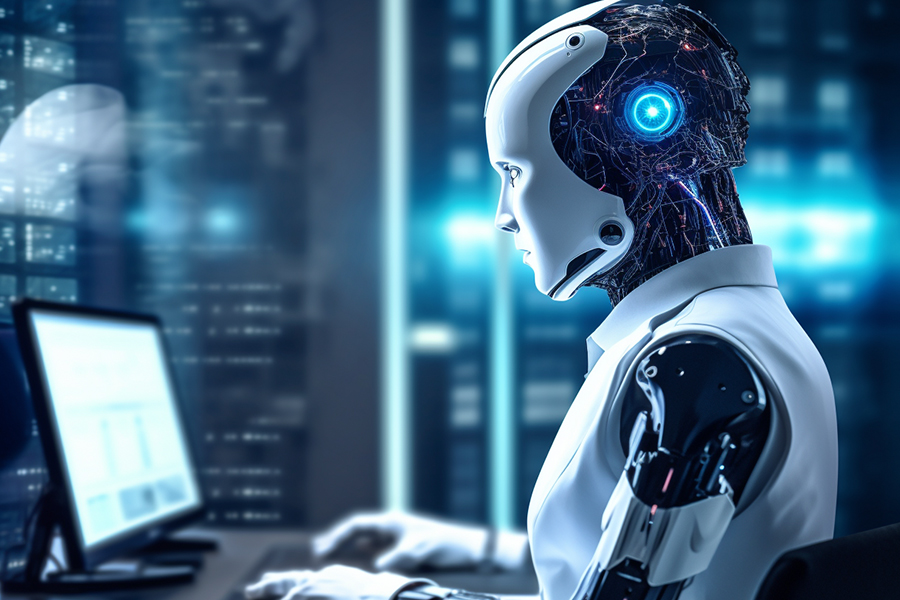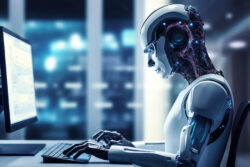It´s always different
Embracing machine learning in ERP organizations helps to optimize and allows business intelligence to make data-driven decisions more efficient. Numerous companies are already partly using a more automated software that integrates rule-based processing for the purpose of automating business tasks, ensuring compliance, and maintaining data consistency.
As we embark on the journey of digital transformation, the fusion of artificial intelligence, SAP ERP, and machine learning algorithms paves the way for ERP solutions. By delivering real-time insights or unparalleled efficiency through automation.
Despite the efficiency gains brought about by rule-based automation, its potential is restricted due to the software’s inability to learn and adapt like humans. Intelligent enterprises address this limitation by automating a significant proportion of their repetitive tasks in day-to-day business operations.
This is achieved through the incorporation of advanced intelligent technologies such as machine learning and AI. As well as learning about the potential of artificial intelligence in the ERP environment. By integrating machine learning into SAP ERP systems, organizations are able of increasing their many different operations with business automation and AI.
With machine learning, we delve into the transformative impact of this groundbreaking integration on businesses of all scales and sectors.
Imagine the possibilities of harnessing data analytics and predictive maintenance within the ERP environment, enabling smarter and more informed decision-making. Sounds mind-blowing, right?
What is meant by machine learning?
Firstly, let´s start by defining what the term machine learning (ML) actually means. It constitutes a technology within the realm of artificial intelligence (AI) that empowers computers to grasp and interpret data for the purpose of executing tasks. The essence of machine learning lies in employing advanced algorithms to obtain insights from extensive datasets. The greater the volume of data that these algorithms are exposed to, the more adept they become at understanding it.
The mechanism behind this involves subjecting computers to the available data, enabling them to adjust and learn from previous computations to discern underlying patterns. This process encompasses the exploration and automation of data through diverse ML algorithms.
As machines become self-capable learners, they are able to make predictions and enhance the algorithms themselves. For instance, this technology aids in recognizing spam, a capability harnessed by nearly all internet security and antivirus software to identify emerging threats.
With the accumulation of experience, machine learning algorithms continually amplify their efficiency. As a technological domain, machine learning has attained remarkable heights and is extensively applied nowadays.
The evolution of machine learning
The evolution of machine learning has been profound since its inception. While it initially gained traction due to its proficiency in pattern recognition, it has now advanced to the point where it can execute complex mathematical computations at an accelerated pace, rendering it immensely valuable. A majority of the tailored recommendations we encounter are rooted in machine learning.
For instance, the route suggestions on Google Maps, product recommendations on Amazon, video suggestions on platforms like Netflix, YouTube, and Hulu, merely scratch the surface of its capabilities.
We now find ourselves in the era of machine learning where machines are entrusted with problem-solving through pattern identification. Analyzing patterns and trends provides a proactive means of averting issues.
Integrate machine learning in your ERP business with Aicomp
With Aicomp as your trusted partner, you can harness the full potential of machine learning algorithms tailored specifically for your ERP needs. Our expertise in ERP solutions, linked with machine learning capabilities, ensures a seamless integration that empowers your business with data-driven insights, enhanced efficiency, and the ability to adapt to evolving industry demands. Together, we will jump on a journey towards a smarter, more agile, and competitive ERP ecosystem that pushes your business into the future.
Machine learning can be applied in the packaging industry to optimize setup as well as runtimes. For instance, ML can be used for:
- Closure Application Optimization:
Some machines may not be able to apply every closure efficiently. Machine learning can help determine which closures are best suited for specific machines, improving closure application accuracy.
- Production Speed Enhancement:
Machines have different speeds for applying closures. Machine learning can be used to predict which closure type should be used for optimal speed, increasing production efficiency.
- Waste Reduction:
By analyzing historical data, machine learning can identify patterns and parameters that lead to less waste during the manufacturing process, helping to minimize material and product wastage.
- Bill of Material (BOM) Optimization:
Different closures can result in variations in the bill of materials. Machine learning can predict the BOM for each product configuration, optimizing material consumption and cost calculations.
- Product Feature Impact Analysis:
Machine learning can assess how changes in product features affect machine setup times, processing times, and waste generation. This analysis helps in making informed decisions about product planning and costing.
- Handling Complex Feature Interactions:
Machine learning is well-suited for handling complex, nonlinear relationships between product features and machine data. It can capture and model various feature combinations’ effects on machine performance.
- Data-Driven Predictions:
Machine learning models can predict manufacturing metrics like runtime, setup time, and scrap based on specific feature combinations. This prediction capability extends to both existing product variants and new, previously unseen configurations.
- Integration with Industry Solutions:
AI and machine learning can be integrated into industry-specific software solutions like VCPowerPack to automate decision-making processes, making them more efficient and accurate.
- Customer Demand Forecasting:
By analyzing customer data, machine learning can forecast consumption patterns and identify trends, enabling better management of material demands and reduced storage costs.
- Recommendation Systems:
Utilizing customer relationship management (CRM) data, machine learning can provide packaging recommendations for specific products, minimizing complaints and enhancing product protection.
- Defect Detection:
Neural networks trained on error patterns can be used for real-time defect detection during the packaging process. This ensures rapid responses to defects, maintains product quality, and reduces complaints.
Jumping to a conclusion
As we conclude this exploration into the profound impact of machine learning in the ERP realm, it becomes abundantly clear that the definition of enterprise resource planning is undergoing a significant shift. No longer confined to mere data management and process automation, ERP systems are now adapting to the constantly changing dynamics of industries.
With the help of machine learning, it is possible to continuously learn from data, recognize patterns, and make informed predictions in not only reshaping the ERP landscape, but also amplifying its role as a strategic asset for organizations. The constant change that characterizes business environments is no longer a challenge but an opportunity, as machine learning empowers ERP systems to respond proactively to shifts, identify emerging trends, and offer insights that drive better decision-making.



